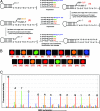Four-color DNA sequencing by synthesis using cleavable fluorescent nucleotide reversible terminators
- PMID: 17170132
- PMCID: PMC1702316
- DOI: 10.1073/pnas.0609513103
Four-color DNA sequencing by synthesis using cleavable fluorescent nucleotide reversible terminators
Abstract
DNA sequencing by synthesis (SBS) on a solid surface during polymerase reaction offers a paradigm to decipher DNA sequences. We report here the construction of such a DNA sequencing system using molecular engineering approaches. In this approach, four nucleotides (A, C, G, T) are modified as reversible terminators by attaching a cleavable fluorophore to the base and capping the 3'-OH group with a small chemically reversible moiety so that they are still recognized by DNA polymerase as substrates. We found that an allyl moiety can be used successfully as a linker to tether a fluorophore to 3'-O-allyl-modified nucleotides, forming chemically cleavable fluorescent nucleotide reversible terminators, 3'-O-allyl-dNTPs-allyl-fluorophore, for application in SBS. The fluorophore and the 3'-O-allyl group on a DNA extension product, which is generated by incorporating 3'-O-allyl-dNTPs-allyl-fluorophore in a polymerase reaction, are removed simultaneously in 30 s by Pd-catalyzed deallylation in aqueous buffer solution. This one-step dual-deallylation reaction thus allows the reinitiation of the polymerase reaction and increases the SBS efficiency. DNA templates consisting of homopolymer regions were accurately sequenced by using this class of fluorescent nucleotide analogues on a DNA chip and a four-color fluorescent scanner.
Conflict of interest statement
The authors declare no conflict of interest.
Figures





References
-
- Collins FS, Green ED, Guttmacher AE, Guyer MS. Nature. 2003;422:835–847. - PubMed
-
- Smith LM, Sanders JZ, Kaiser RJ, Hughes P, Dodd C, Connell CR, Heiner C, Kent SB, Hood LE. Nature. 1986;321:674–679. - PubMed
-
- Prober JM, Trainor GL, Dam RJ, Hobbs FW, Robertson CW, Zagursky RJ, Cocuzza AJ, Jensen MA, Baumeister K. Science. 1987;238:336–341. - PubMed
-
- Kan CW, Doherty EA, Barron AE. Electrophoresis. 2003;24:4161–4169. - PubMed
Publication types
MeSH terms
Substances
Grants and funding
LinkOut - more resources
Full Text Sources
Other Literature Sources

